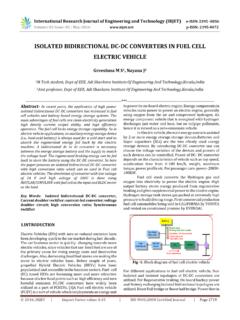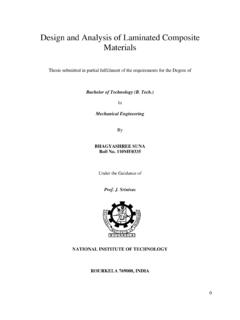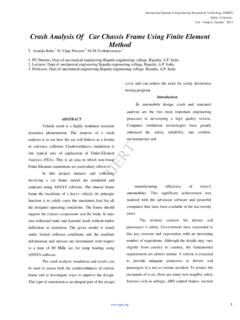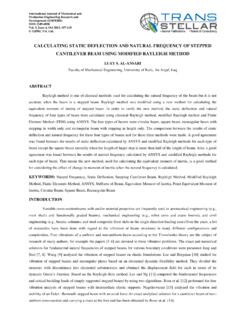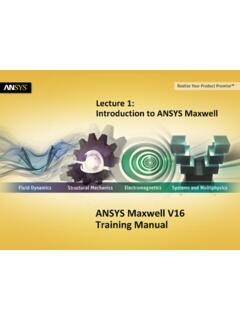Transcription of Design of pressure vessel using ASME codes and a ...
1 International Research Journal of Engineering and Technology (IRJET) e-ISSN: 2395-0056 Volume: 04 Issue: 11 | Nov -2017 p-ISSN: 2395-0072 2017, IRJET | Impact Factor value: | ISO 9001:2008 Certified Journal | Page 617 Design of pressure vessel using ASME codes and a comparative analysis using FEA Arun , , Amith 1 Department of Mechanical Engineering, Dr. Ambedkar Institute of Technology Bengaluru, Karnataka, India 2 Professor Department of Mechanical Engineering, Dr.
2 Ambedkar Institute of Technology Bengaluru, Karnataka India 3 Assistant Professor Department of Mechanical Engineering, Dr. Ambedkar Institute of Technology Bengaluru, Karnataka India ---------------------------------------- -----------------------------**--------- ---------------------------------------- --------------------Abstract - pressure vessels are the most used storage equipment in the industrial engineering. They also find wide usage in the process and other mechanical manufacturing industry. The pressure vessels are subjected to varied type of loads and need to be checked for structural safety to prevent any possible failure.
3 Present technology has the advantage of checking the structural safety by virtual simulation with out going for costlier destructive experimental techniques. Key Words: Engineering components, Computational fluid dynamic, Impact velocity and pressure , burst pressure , Inertia of solid section, Shell elements , Transient analysis 1. INTRODUCTION A container mainly designed for storage of fluids or gas or called pressure vessels. pressure vessels are generally designed with difference of pressure inside and out side of the vessel .
4 Normally pressure inside is more then outside of the pressure vessel excepting for few cases like submarines. The substance inside the pressure vessel may undergo change of phase like water to vapour etc. In the chemical reactors, the substance may mix with some other chemical substance forming a chemical reaction. These type of conditions require the safety of the vessel to prevent possible bursting or cracking spoiling the entire manufacturing process operations. pressure vessels find wide applications in Power generation industries Nuclear industries Petrochemical industry Domestic applications Medical industry Automobile Industry Aerospace Industry pressure vessel The figure shows typical pressure vessel components.
5 Main components of pressure vessel include shell , head, nozzle openings, support structures etc. The dome is connected to main shell by welding. Due to number of openings for either inlet or outlet, stress concentration is more on the structure. The stress concentration will also vary due to the size of hole, location of hole and shape of hole. Generally circular holes create a stress concentration effect of 3 and other variations generally create less then 3. Further the overhung structures create bending stress on the pressure vessel .
6 Since the joint is made by weld, thermal effects create residual stress in the pressure vessel . Applications of pressure vessel pressure vessel for Storage(Nitrogen) International Research Journal of Engineering and Technology (IRJET) e-ISSN: 2395-0056 Volume: 04 Issue: 11 | Nov -2017 p-ISSN: 2395-0072 2017, IRJET | Impact Factor value: | ISO 9001:2008 Certified Journal | Page 618 pressure vessel for Non-firing Applications 2.
7 LITERATURE SURVEY Since pressure vessels are very common and found large usage, much literature is available on usage, Design and manufacture. Few of the studies related to pressure vessels are represented as follows. AlberKaufman[1] has done lot of research on stresses and strain development in the pressure vessels. He also done research on pressure vessels with reinforcements. He extended his research on the problems in plastic range also to find cracking time. He has used ultimate strength of the material to find the final bursting pressure of the pressure vessels.
8 Also he has done research on estimating the progressive process of elasto-plastic deformation of the system under increased loading [2] has research on the pressure vessel openings to find stress concentration using thin spherical pressure vessels. Chart -1: Name of the chart 3. PROBLEM DEFINITION AND finite ELEMENT MODEL DEVELOPMENT Problem Definition: Design of pressure vessel major dimensions for the given pressure load and Design optimization of the weld region is the main definition of the problem. The main objectives are Thickness calculation by ASME codes Geometrical built up of the problem finite element optimization Methodology: Geometrical specification of the pressure vessel Thickness calculation from ASME codes finite element verification of the code Design optimization using finite element analysis Results representation Design Requirements Inner diameter of the pressure vessel d=3500mm Design pressure : Hemispherical dome Allowable stress: 170 Mpa Specification of the Material: Name of the material : SA516 Elastic Modulus.
9 200 Gpa Poison s ratio= Density=7800kg/m3. Yield Strength =335 Mpa Calculations AS per UG27: (Validation for the Drawing) P:internal Design N/mm2. R: inside radius of the shell:1750mm S: maximum allowable stress:170N/mm2 T:minimum thickness required E:Joint Thickness Calculations as per UG27 : Formulae for shell thickness as per UG27 T=PR/( ) T= *1750/(170* * ) T= ~45mm. Hemi spherical Thickness calculation based on UG27 Td=PL/(2= ) Td= *1750/( *170* * ) International Research Journal of Engineering and Technology (IRJET) e-ISSN: 2395-0056 Volume: 04 Issue: 11 | Nov -2017 p-ISSN: 2395-0072 2017, IRJET | Impact Factor value: | ISO 9001:2008 Certified Journal | Page 619 Td= mm Standard size of 27mm is considered for dome thickness.
10 : Geometrical model of the problem The shows geometrical configuration of the pressure vessel system. Inner diameter of the pressure vessel is 3500mm and outer diameter is 3590mm with thickness equal to 45mm. Total height of the system is around 22037mm. The pressure vessel is having spherical dome with thickness of 27mm. The geometry is built using Solid Edge software Version 19. Stress calculations from theoretical formulas: Di/t = 3500/45= Here Di= inner diameter of the pressure vessel t= thickness of the pressure vessel Hoop Stress h=pd/2t= *3500/(2*45)= This value is far away from the allowable stress value of 170 Mpa for the given pressure vessel .







